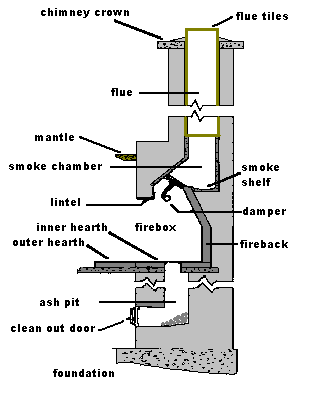Fireplace Anatomy
Fireplace Anatomy
While there are differences among the various types of fireplaces, you will find common parts. An understanding of the basic terminology of fireplace anatomy is helpful. CONTACT US for a free estimate.
- Outer Hearth: This is the technical term for what we usually call the hearth. It is the part of the hearth that extends out into the room, beyond the fireplace opening.
- Inner Hearth: The floor of the fireplace, inside the opening.
- Firebox: This is the space in which you build the fire, on the inner hearth.
- Fireback: The rear wall of the firebox.
- Damper: A plate or valve that closes the fireplace flue when the fireplace is not in use. You must fully open it before lighting the fire.
- Throat Damper: A damper located in the throat of the fireplace, just above the firebox. This is the kind found in most fireplaces, and is operated by means of either a handle inside the firebox or a knob above the fireplace opening connected to a rotating metal shaft attached to the damper.
- Smoke Chamber: The somewhat triangular shaped space above the throat of the fireplace leading up to the flue.
- Flue: The vertical passageway up the inside of the chimney.
- Ash Dump Door: A metal door located on the inner hearth of some fireplaces, which leads to an ash pit.
- Ash Pit: A cavity underneath a fireplace firebox, used as a receptacle for ashes, and accessible for clean-out by means of a clean-out door.
- Ash Pit Clean-out Door: A metal door located at the base of the chimney which leads to the ash pit.


